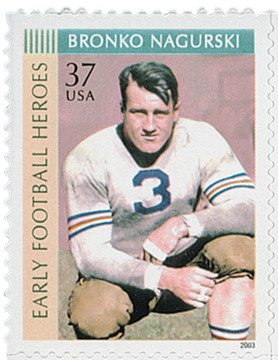
U.S. #3811
37¢ Red Grange
Early Football Heroes
Issue Date: August 8, 2003
City: South Bend, IN
Printed By: Avery Dennison
Printing Method: Photogravure
Perforations: Serpentine Die Cut 11.5 x 11.75
Quantity: 70,000,000
Color: Multicolored
Birth of Red Grange
Howard Edward “Red” Grange was born on June 13, 1903, in Forksville, Pennsylvania. Considered one of football’s greatest running backs and one of the best college football players of all time, he was a three-time all-American and two-time NFL champion.
Grange was a talented athlete from a young age. During his four years in high school, he earned 16 varsity letters in football, basketball, and track. Grange scored 75 touchdowns and 532 points for the football team alone. He developed speed on the track and agility, coordination, and ball-handling skills on the basketball court. Grange also delivered ice to help support his family, a job that earned him the nicknames “Ice Man” and “the Wheaton Ice Man” (he was living in Wheaton, Illinois at the time).
Grange went on to attend the University of Illinois, where he joined the track, basketball, and football teams. In three seasons at the University of Illinois, Grange scored 31 touchdowns, rushed for 3,637 yards, and was named all-American three times. He became known as the Galloping Ghost in 1924 when he scored five touchdowns against Michigan, four in the first 12 minutes of play. Damon Runyan wrote that Grange was “three or four men, and a horse rolled into one for football purposes. He is Jack Dempsey, Babe Ruth, Al Jolson, Paavo Nurmi and Man o’ War.”
During his college career, Grange played in 20 games, caught 14 passes for 253 yards, completed 40 of 82 passes for 575 yards, and scored at least one touchdown in almost every game. He was also featured on the cover of Time magazine in October 1925. He was the first recipient of the Chicago Tribune Silver Football award, and in 2008, ESPN named him the best college football player of all time.
In 1925, Grange joined the Chicago Bears of the National Football League (NFL). He was the last player to play on both college and NFL teams in the same season. The Red Grange Rule was passed the following year to prevent future players from doing this. In late 1925, Coach George Halas took the team on a grueling “barnstorming” tour. This let thousands of new professional football fans see Grange in action and greatly stimulated public interest in the sport. Some credited Grange with helping to save the NFL and professional football.
In 1926, Grange helped found the New York Yankees football team and the American Football League, both of which were short-lived. When Grange suffered a knee injury in 1927, it affected his running game. He missed the 1928 season but returned to the Bears in 1929. Grange said, “I did develop into a pretty good defensive back, however.” In 1932, with the Iceman’s touchdown, the Bears beat the Portsmouth Spartans for the NFL championship. Grange retired from playing in 1934 and worked as backfield coach for the Bears until 1937.
At the height of his football career, Grange also explored acting. He appeared in a 1926 silent film, One Minute to Play, the 1927 racing film, A Racing Romeo, and the 1931 12-part series The Galloping Ghost, in which he performed his own stunts. After leaving football in 1937, Grange worked as a motivational speaker, sports announcer, and insurance broker. He was also president of the National Girls Baseball League and served on the Board of Trustees of the University of Illinois. He developed Parkinson’s and died on January 28, 1991.
Grange is considered one of football’s greatest running backs. Grange is often included on “top players” lists and in 1969 was the only unanimous choice of the Football Association of America’s All-Time All-America team. The University of Illinois has a 12-foot statue of Grange and Pennsylvania’s Abington High School named their mascot the Galloping Ghost after him. In 1978, he was the first person other than a referee to flip the coin at the Super Bowl.









